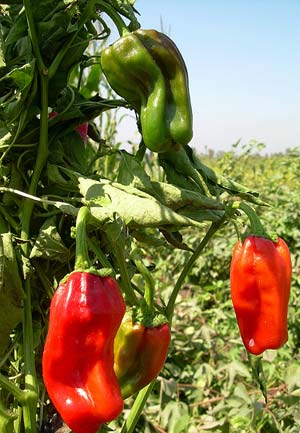|
|
Pythium root rot is the most important soil-borne disease problem in the Queensland capsicum industry. It can cause heavy losses to seedlings when temperatures are high or wet weather occurs within a few weeks of planting, and is thought to be involved in a disease of mature plants known as sudden wilt. This report describes research on the control of Pythium root rot on capsicum in tropical and subtropical environments. Evidence is presented which shows that reducing soil temperatures to levels that are unfavourable to heat-tolerant Pythium species is the most important control measure. Other useful management practices include improving the biological suppressiveness of soil with amendments of organic matter and reducing pathogen activity with chemicals such as metalaxyl, phosphite and silica.
Findings : Pythium root rot is the most important soil-borne disease in Australia’s tropical and subtropical capsicum industry. Pythium myriotylum, P. aphanidermatum and other species of Pythium with high optimum temperatures kill seedlings when temperatures are high or soil is too wet during the first few weeks after planting, and are involved in a disease of mature plants that is known locally as sudden wilt. The objective of this work was to minimise the impact of Pythium root rot by modifying soil management practices, enhancing biological suppression of Pythium and controlling the pathogen with chemical and non-chemical treatments. Previous work has shown that high soil temperatures and heat stress are important components of the Pythium root rot syndrome. The effects of changing plastic colour, modifying mulching practices and varying planting configurations were therefore investigated. Experiments with plastic colour showed that soil temperatures increased when black rather than white plastic was used as mulch, and this had a major impact on disease severity. In contrast, seedling mortality declined in plant-based mulches that were either laid manually or produced in situ, largely because soil temperatures were reduced. This result suggests that minimum till production systems in which seedlings are planted into in situ mulch should be further investigated from a soil health and disease minimisation point of view. Dense planting configurations (e.g. double rows) provided more shade than single rows and are therefore likely to improve control of Pythium root rot, particularly if they are used in conjunction with white rather than black plastic. A series of experiments were done to investigate the role of organic matter in enhancing natural biological mechanisms of disease control. Incorporation of a forage sorghum green manure crop was found to exacerbate Pythium root rot if capsicum seedlings were planted within a month of incorporation, largely because Pythium is a good competitive saprophyte and is capable of colonising fresh organic matter. However, when organic matter was introduced 4-6 months before capsicums were planted, losses due to Pythium root rot were reduced. This effect was observed in field plots amended with sugarcane trash plus nitrogen; in bioassay plants grown in undisturbed cores containing soil previously amended with sugarcane trash, nitrogen and compost; and in a pot experiment with soil amended with sugarcane trash or lucerne hay. In all cases, root rotting was less severe as soil microbial activity increased. Three chemicals with potential to provide control of Pythium root rot were also investigated. Metalaxyl was effective against the seedling stage of the disease, provided it was applied to potting mix just before seedlings were transplanted, or drenched around seedlings as they were planted. Phosphite was not as effective as metalaxyl, but foliar sprays increased phosphite concentrations in roots to levels known to control Phytophthora, a closely related root rotting pathogen, and reduced the severity of root rotting in capsicum seedlings by about 30%. Silicon was also a potentially useful control measure, as disease severity was reduced when SiO2 was drenched around the roots of capsicum seedlings in the glasshouse. However, it may be some time before these products are available for use by vegetable growers. Phosphite and EC formulations of metalaxyl are not registered for use on vegetable crops, while field studies on the efficacy and economics of using silicon for root disease control are yet to commence. Acknowledgements : This work would not have been possible without help from others. Ms Rosemary Kopittke advised on statistical analyses, Chrys Akem and Tony Parker helped with field trials in north Queensland, and Neil Halpin kept a watchful eye on trials in Bundaberg. Dale Reibel, Alan Napier and Joe Totorica cooperated with field trials at Bowen and Gumlu, while Don Halpin was an excellent co-operator at Bundaberg. Don managed our trials professionally and was always willing to accommodate experimental requirements that inevitably made his job more difficult. This research was funded by the Australian Capsicum industry and Horticulture Australia (HAL). The Australian Government provides matched funding for all HAL’s R&D activities. |
||||
|

